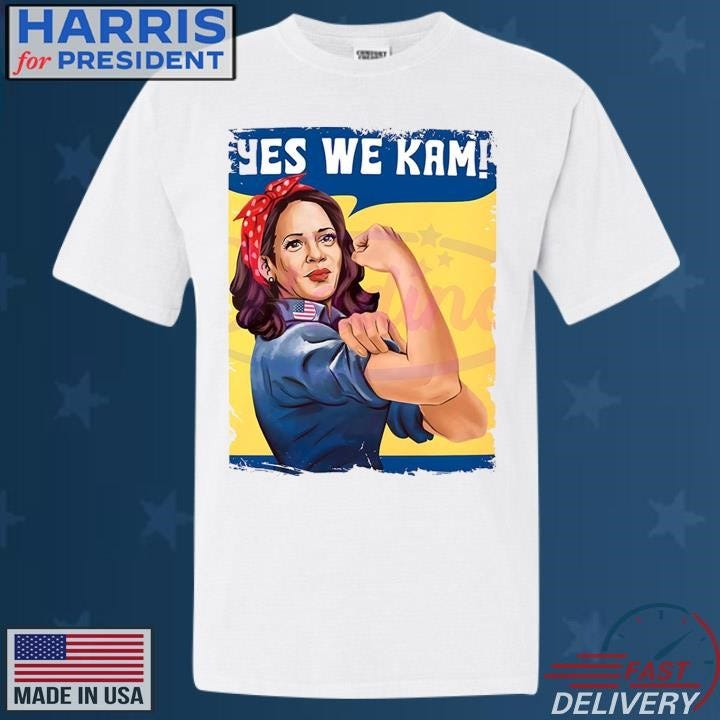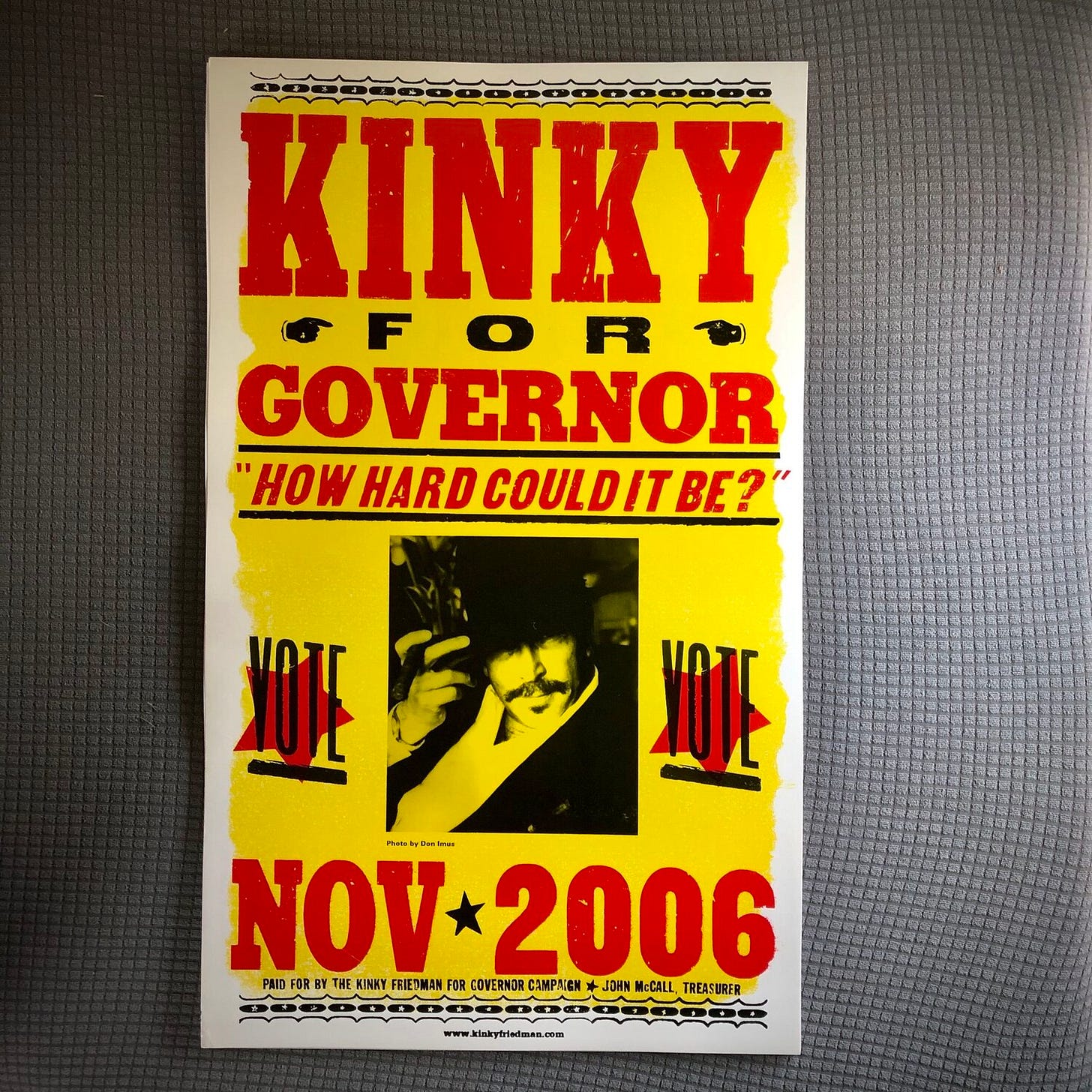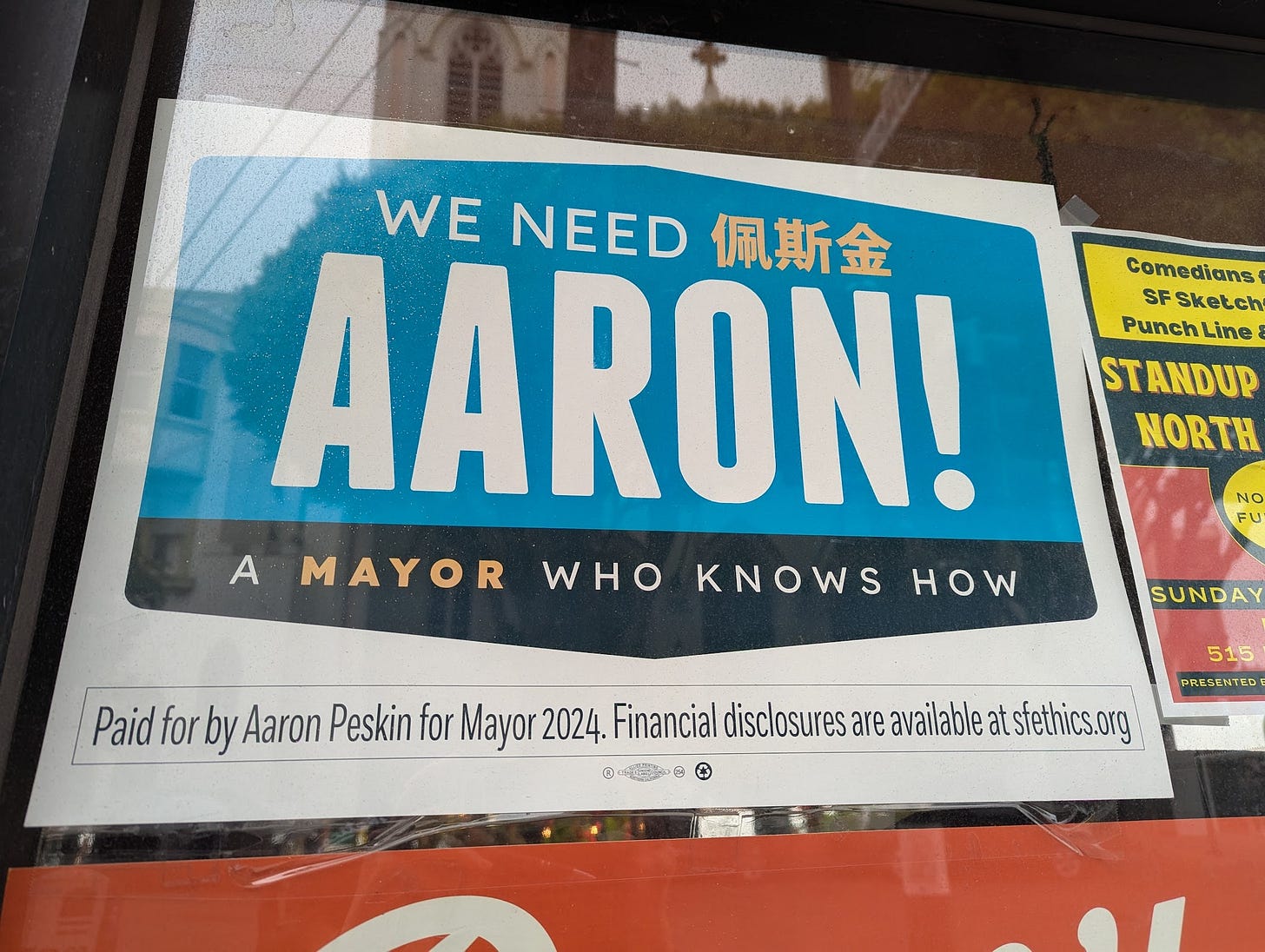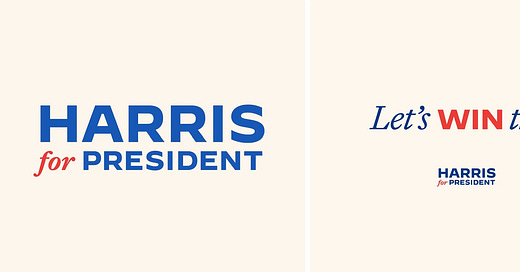That was fast.
Less than 24 hours after President Biden announced his departure from his 2024 reelection campaign, Vice President Kamala Harris unveiled her own campaign logo — well, wordmark, if you want to get picky — and slogan. The overnight work was done by New York City designer Ana Rice and her team (all women, as she told her X/Twitter followers).
Note: This newsletter is probably too long for email. To read the full post, I recommend using the Substack app or your browser.
So what do we have here?
A little more than meets the eye, and a little less than would satisfy my curiosity.
Reporter Hunter Schwarz broke it down for Fast Company readers:
Rather than reaching back to Harris’ 2020 campaign logo and its unconventional (for politics) purple, red, and yellow color palette, the logo was designed to match the preexisting Biden-Harris campaign identity.
(I wrote about Harris’s 2020 campaign marketing in a story about all the Democratic candidates’ slogans that I published in July 2019, before Harris dropped out of the race.)
Schwarz continues:
, who writes newsletter from Scotland, focused on another element of the branding:Harris’ logo uses a red, white, and creme1 color palette. And the sans-serif typeface in Harris’ new logo, Decimal, has been used by Biden since his campaign rebranded for the general election in 2020, a month before he named Harris as his running mate.
The result is a logo that’s safe and familiar. It communicates continuity—a hallmark of visual design for vice presidential running mates who later run for the top job. That continuity isn’t just for the branding either. Harris is inheriting the Biden-Harris campaign’s staff, headquarters, and bank account.
More interesting is “Let’s WIN this”. I’m not usually a fab [fan?] of italics outwith2 body copy, but this works because of the solidity of the “WIN” in the middle. Visually it has movement and urgency as well as emphasis. The slogan has echoes, presumably deliberate, of Nike’s “just do it” and similarly has a full stop. The full stop is important. It makes it a statement rather than just three words. It provides additional emphasis. They say if you want something done, ask a busy woman. This has that spirit. In message terms the “WIN” is important. This is not just someone standing for office, this is someone with energy entering the race at the last minute, pushing for a historic victory over dark forces in a contest with high stakes. The logo is all about energy.
Farquharson makes a strong case, but I’m still disappointed.
Who cares?
I do! I care about slogans because slogan-making is part of my job description. (I’ve never created a political-campaign tagline, though. If you need one, get in touch!) I believe that a well-crafted slogan can do a lot of heavy lifting, distilling a campaign’s character and energy into three, four, or five well-chosen words.
Like a brand name, a slogan needs to be distinctive: to stand out from the competition. And here’s my gripe: “Let’s WIN this” — with or without the full stop (period, in American English) — is the opposite of distinctive. Anyone could claim it. Is there a candidate alive who would say “Let’s LOSE this”?
“Let’s WIN this” tells me nothing about the candidate’s qualifications, experience, goals, or plans. It tells me only of her ambition. It’s a safe, watered-down edit of #LFG — “Let’s Fucking Go” — the brash slogan adopted by Senator Elizabeth Warren during her 2020 presidential campaign. It’s an easy, safe variation on Joe Biden’s “Let’s do this,” which in turn, as Kenny Farquharson noted, echoes the Nike slogan “Just do it” . . . which was inspired by convicted murderer Gary Gilmore’s last words: “Let’s do it.”
So no, I’m not keen on it. But your mileage may, and probably does, vary. When I posted a link to “Let’s WIN this” on Substack Chat, two readers responded positively.
James Petrie wrote: “I like it. Succinct and sums up what I sense is the nature of the excitement of the past several days.” He added: “It seems to capture the current vibe around her candidacy. The unspoken part, what exactly this is, is open to the individual to define. It could be win the fight against the rollback of abortion rights, move to a more carbon neutral energy future, etc. Whether it will feel too generic a month from now is a question.”
And
, while acknowledging that the tagline “feels pretty generic,” speculated that “maybe it’s smart to capitalize on the surge in energy + focus on the actionable target of the election, rather than anything loftier. Also timely given the Olympics etc.”OK. Points taken. And I’ll add that I’m glad to see a period after “Let’s WIN this” instead of the overused exclamation point.
I’m still disappointed.
You can’t please ’em all.
I’d been planning to write about campaign slogans even before I learned about Harris’s new marketing. I’d wanted to riff on Pamela Paul’s July 17 op-ed column for the New York Times, which ran under the headline “‘Finish the Job’ Is a Terrible Slogan” (gift link). Remember “Finish the Job”? No? It was President Biden’s campaign slogan, and while I don’t agree that it was “terrible,” I do think that it feel short in the inspiration department. As Paul wrote:
“Finish the job” is a patient gardener determinedly clipping away at that final hedge. It’s an accountant hunched over the last page of his trusty ledger.
It looks backward rather than forward.
“Finish” also evokes “He’s finished.” Which turned out to be prescient.

Are there any good political slogans?
They’re hard to find in an era of focus groups and consensus-seeking. We’re a long way from the eras that gave us “Tippecanoe and Tyler Too” (from 1840, and considered the first American political slogan), “No Cross of Gold, No Crown of Thorns” (William Jennings Bryan, who lost in 1896 to William “Patriotism, Protection, and Prosperity” McKinley), or “In Your Heart, You Know He’s Right” (Barry Goldwater, soundly defeated in 1964 by “All the Way with LBJ” and by the jeering riposte “In Your Guts, You Know He’s Nuts”). Or even “I Like Ike,” the slogan that propelled an initially reluctant Dwight D. Eisenhower into the White House in 1952; the slogan had been modified by Roy Disney — Walt’s brother — from a song that Irving Berlin wrote for the 1950 musical Call Me Madam.3
But originality sometimes prevails. Take a look at Kamala Harris’s marketing for the 2020 presidential election, mentioned above.
It was an unsuccessful campaign, but in my eyes the marketing was a home run. The color palette was unorthodox (for politics) and eye-catching; the slogan was unlike any other candidate’s and authentically reflected the unique qualifications of Harris, a former district attorney. (“Ready for the people” is how prosecutors introduce their case.4 ) Some critics thought that posed a problem (“She’s a cop!”). But “For the people” also echoes the Gettysburg Address: “. . . that this nation, under God, shall have a new birth of freedom and that government of the people, by the people, and for the people shall not perish from the earth.”
And I know I’m going to catch some flak for this, because she is often dismissed as a nut job, but Marianne Williamson — still in the Democratic race, by the way — has created some elegant and effective marketing in both of her quixotic presidential campaigns.


In the Chat, Nancy Schimmel brought up the entertainer and peace activist Hugh Romney, aka Wavy Gravy5, who once ran for Berkeley (California) City Council on the slogan “Elect a REAL Clown!”
But for sheer cheekiness it’s hard to beat the political slogans of the late, great Richard “Kinky” Friedman (no relation, alas), founder of the Texas Jewboys band and candidate for governor of Texas in 2006. His campaign taglines included “How Hard Could It Be?”, “Why The Hell Not?”, “My Governor Is a Jewish Cowboy,” and “He Ain’t Kinky, He’s My Governor.” Yee-haw!

Local slogan makes good.
I’m not eligible to vote in San Francisco (I live across the bay, in Oakland), so my endorsement of mayoral candidate Aaron Peskin’s slogan is unbiased. (Well, except for the fact that Peskin, in addition to being president of the San Francisco Board of Supervisors, is a fellow bay swimmer, which boosts his rating in my book.) I like that his slogan doesn’t look recycled or AI-generated.

Yes, AARON! has echoes of the unfortunate Jeb Bush’s Jeb! in 2016. (Jeb Bush’s official slogans were “Jeb Can Fix It” and #AllInForJeb, which were, as they say, #cringe.) But “A Mayor Who Knows How” is good. Here’s how Peskin’s campaign website puts it:
We used to be called “the city that knows how.” But today, our city is struggling. That’s why we need Aaron! Called even by his critics “San Francisco’s most effective Supervisor,” Aaron will be the Mayor who knows how.
Why was San Francisco called “the city that knows how”? President William Howard Taft bestowed the nickname out of admiration for the city’s can-do spirit: In 1911, less than five years after the Great Earthquake and Fire leveled great swaths of the city, San Franciscans broke ground on the Panama Pacific International Exposition. The fair opened in 1915, on schedule and within budget.6
I like Peskin’s slogan for its appeal to history (always a big deal for San Franciscans) and its evocation of the candidate’s long experience in public service. Will he win? I have no idea; he’s considered a leftie, and San Francisco is also a city that knows how to kowtow to business interests, which are well represented in this 13-candidate mayoral race.
Again, again.
The standout example of 20th-century presidential sloganeering is the gauzy commercial crafted and narrated by gravel-voiced Hal Riney for the incumbent, Ronald Reagan, in 1984. The ad’s actual title was “Prouder, Stronger, Better,” but it’s been forever known by its first line: “It’s Morning Again in America.”
There’s something about that word again that has proved almost as irresistible to politicians as their own names. Not only did Reagan himself use “Let’s Make America Great Again” (in 1980), but Bill Clinton, a Democrat, appropriated it in speeches during his two terms in the White House (1992–2000). And then there’s The Former Guy himself, Donald J. Trump, who has used “Make America Great Again” twice (2016, 2020)7 and has awkwardly tweaked it for his third run.
Not that I’d accept the job, but I’d have advised against shoving “Once” in there. It tends to remind people that you held the office just the one time. Also, while “MAGA” has been an undeniable success — even opponents have glommed onto it, turning it into “MAGAt,” pronounced “maggot” — “MAGOA” has “loser” written all over it. It reminds me of fumbling old J. Quincy Magoo.
Let’s wrap this up.
Slogans can, and sometimes do, change over the course of a campaign, although with less than four months remaining in this cycle, it’s unlikely the Harris team will choose to put additional energy or money into a new creative round. If they do (and I wish they would), I’d advise against a line that got a lot of play during Harris’s first solo campaign rally: “Not going back.” Yes, the intent of the chanters is “We’re not returning to the chaos of the Trump administration.” But it’s just as easy to read the line as “We’re not going back to the White House.” And you can bet that’s how the other side would twist it.
What would I recommend? I’d revisit “For the People.” Lean into the Lincolnesque resonance. (Lincoln was a Republican. Unity!) And build it up and out: Opportunity for the People. Choice for the People. Energy for the People. And: Working for the People — All the People.
Vice President Harris, I look forward to your call.
I have no idea why he spells it that way.
What a great old word! It’s a “chiefly Scottish” preposition, says the OED, that means “outside of.”
“I Like Ike” is essentially as meaningless as “Let’s WIN this” — so you like the candidate; so what? — but you can’t deny its rhyming appeal. The Russian-American linguist Roman Roman Jakobson (1896–1982) admired the slogan’s “poetic function”: like contains Ike, which contains I. The slogan thus gives us “a paronomastic image of the loving subject enveloped by the beloved object.” (Paronomasia is a fancy way to say “wordplay.”)
It also happens to be the title of a very good book by my friend Marissa Batt, herself a former prosecutor.
According to a Wikipedia entry, Mr. Gravy has a son, “born in 1971 as Howdy Do-Good Gravy Tomahawk Truckstop Romney, who has since become known as Jordan Romney.”
I’m including the link to the National Park Service article despite its many regrettable proofreading errors: “Rueben Hale” should be “Reuben Hale,” “$5 million dollars” should be “$5 million,” “worlds’ fair” should be “world’s fair,” etc.









I think the fact that people remember "I Like Ike" some 70 years later indicates that it doesn't have to mean-mean a lot, it just has to be memorable. I find "Let's Win This" short and sweet, evocative of a halftime speech by a coach who's rallying the team. Which is very much where we are. The goal here is not to evolve the country, or make it great (once) again, or anything suggestive of a policy. There is one goal: win the election. Nothing else really matters.
Trenchant, as always. I’m keen to discuss this:
The first syllable of “Kamala” rhymes more closely with “mom” than with “gram.” Yes, I’m picky.
Last night I had dinner with a fellow who rhymed her name with “gram.” His wife and I both corrected him that it’s “Comma-la” as she puts it. He said, But it doesn’t start with a “C.” He persisted until I said, “Kamala” is a Sanskrit word that means “lotus” and Kamala is an English word that means POTUS. (Stolen from social media, natch.) He laughed and is not apt to forget.